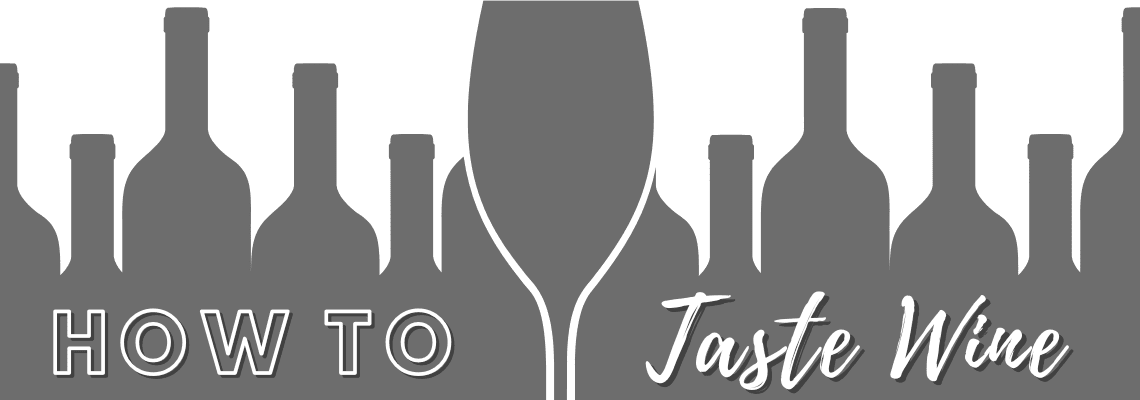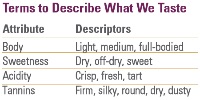Hundreds to thousands of flavor compounds distinguish one wine from the next and make tasting each wine its own experience. There is no right or wrong way to interpret our impressions when we taste.
The wine tasting experience examines appearance, aroma and taste.
Appearance - Tilt the glass 45° in front of a white background and examine the color.
- Swirl the glass and note the “legs” or “tears” on the side of the glass. This may indicate a higher alcohol level.
- Examine the color.
Color: A Cue to Style and Age - For whites, green or straw tints can suggest a lighter-bodied, youthful, fresh wine like Sauvignon Blanc.
- A gold or deep yellow in whites can indicate a fuller-bodied, oak aged wine like some Chardonnays or Sauternes.
- Deep, purple-red can indicate a younger, fuller, robust red like a Cabernet Sauvignon, Tempranillo or Malbec.
- A lighter ruby red can signify a younger Chianti or Pinot Noir.
- Brown can indicate a wine is oxidized; good for a Sherry or Tawny Port but a flaw for most others.
Aroma - Avoid distracting scents like perfume or cigarettes before tasting.
- Swirl the wine in the glass to aerate it and optimize the release of aromas.
- Isolate the different aromas and note their intensity.
- Using the aroma chart, identify individual aromas you detect.
Tasting Wine Means Smelling Wine - The nose can detect over 1,000 aromas; the tongue detects only five flavors.
- With five to six million smell receptors, each person’s perception of smell is subjective and may detect unique aromas.
- Many wine varieties are easily identified by their signature aromas. Tar and roses are classic aromas for Nebbiolo; for Sauvignon Blanc, it’s gooseberries.
Taste - Cleanse your mouth with a cracker or bread before taking your first sip.
- Swish the wine around your palate and evaluate its flavors, texture and body.
- Determine whether the flavors confirm the aromas.
- Form conclusions about the wine’s characteristics and grape variety.
- Note how long the wine’s flavors last in the mouth and how they evolve after you’ve swallowed.
Where the Tongue Senses Flavors - Sweet: A tingling sensation at the tip of the tongue indicates residual sugar.
- Sour: Salivation triggered on the sides of the tongue indicates pronounced acidity.
- Bitter: A drying effect at the back of the tongue indicates concentrated tannins
“The Finish” - The wine’s aftertaste is appropriately called the finish.
- A basic metric of quality is how long a wine’s taste remains on the palate.
- Great wines have flavors that linger in the mouth for several minutes and can remain in the taster’s mind for a lifetime.
Citrus Fruits
Lime, Grapefruit, Lemon, Orange, Peel, Blood Orange
Green Fruits
Green, Apple, Pear, Gooseberry, Grape Skin, Green Plum
Stone Fruits
Apricot, Nectarine, Peach
Tropical Fruits
Pineapple, Litchi. Melon. Banana, Kiwi, Mango Coconut, Guava, Passion, Fruit
Red Fruits
Cherry, Wild Cherry, Sour Cherry, Raspberry, Red Currant, Strawberry, Wild Strawberry, Cranberry
Black Fruits
Blackberry, Black Raspberry, Boysenberry, Black Currant, Black Cherry, Plum, Blueberry
Dried Fruits
Raisin, Prune, Fig
Floral
Honeysuckle, Orange Blossom, Elderflower, Apple Blossom, Rose Petal, Lilac, Violet, Pear Blossom, Jasmine, Lavender
Confection
Marmalade, Jam, Honey, Caramel, Butterscotch, Toffee, Brown Sugar, Molasses, Bubblegum
Herbaceous or Vegetal
Cut Grass, Hay, Lemongrass, Asparagus Sage, Dill, Mint, Eucalyptus, Tea, Dried Herbs, Anise, Bell Pepper, Tomato Skin
Animal
Wet Wool, Leather, Gamey, Musk, Lanolin, Saddle Leather
Spice
Nutmeg, Cinnamon, Pepper, Clove, Ginger, Licorice,, Cardamom
Earthy
Mushrooms, Wet leaves, Moss, Forest Floor, Barnyard, Truffles, Beeswax
Woody
Oak, Cedar, Smoke, Tobacco, Sawdust, Sandalwood
Nut & Bean
Woody, Vanilla, Almond, Hazelnut, Walnut, Chestnut, Chocolate, Coffee, Cola, Espresso
Mineral
Flint, Slate, Steel, Tar, Wet Stones, Pencil Lead, Rubber, Petrol,
Bread
Fresh Bread, Biscuits, Brioche Toast, Butter. Yeast
Liqueur
Cassis, Kirsch
[ courtesy of Kobrand Fine Wines and Spirits ]
|









